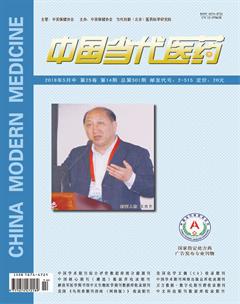右美托咪啶在小儿中应用的研究进展
李雅倩 范俊柏 陈丽
[摘要]右美托咪啶(Dex)自上市以来在成人中的应用得到了认可。小儿麻醉相对于成人具有特殊性,小儿术前焦虑、哭闹,术后疼痛、谵妄等,增加了手术及麻醉的风险,同时也容易给小儿造成心理及生理的创伤,故小儿的麻醉用药也一直在探索和发展。鉴于Dex的临床优点,国内外的医学工作者将其用于小儿的治疗及研究中。本文就其在小儿的药效学与药代动力学、对小儿生理的影响及在临床新领域应用的进展进行综述。
[关键词]右美托咪啶;小儿;临床应用;研究进展
[中图分类号] R614 [文献标识码] A [文章编号] 1674-4721(2018)5(b)-0025-04
Advances in clinical application of Dexmedetomidine in children
LI Ya-qian1 FAN Jun-bai2 CHEN Li2
1.Department of Anesthesiology,Shanxi Medical University,Taiyuan 030000,China;2.Department of Anesthesiology,the Second Hospital of Shanxi Medical University,Taiyuan 030001,China
[Abstract]Dexmedetomidine (Dex) has been recognized by most physicians since its application in adults.Pediatric anesthesia has many particularities,preoperative anxiety,crying,postoperative pain,delirium,etc.which not only increase the risk of surgery and anesthesia,but also easy to cause psychological and physical trauma in children.So anesthesia medication of pediatric has been exploring and developing.In view of the advantages of Dex in clinical,domestic and foreign medical workers use it in pediatric treatments and researches.This review is aimed to discuss the progress of its application in pediatric filed from four aspects: pharmacokinetics and pharmacokinetics,pediatric physiology and clinical application.
[Key words]Dexmedetomidine;Children;Clinical application;Advances
右美托咪啶(Dexmedetomidine,Dex)是一种高选择性α2肾上腺素能受体激动剂(α2∶α1=1600∶1),其受体结合力是可乐定的8倍,主要作用于脊髓及脊髓上水平的相关受体。α2肾上腺素能受体分为 α2A、α2B、α2C三种亚型,而Dex主要作用于α2A受体,具有镇静、镇痛和抗交感神经作用[1],与传统的镇静药相比,具不抑制呼吸的优点。α2A 受体主要分布于蓝斑,Dex作用于此,产生类似生理睡眠时非动眼快速时相的镇静作用,易唤醒,无明显呼吸抑制;作用于脊髓α2A受体,抑制痛觉信号上行传输,发挥镇痛作用;作用于突触后α2肾上腺素能受体,抑制去甲肾上腺素释放,降低血压及心率。1996年FDA批准其用于重症监护病房气管插管镇静,2008年批准其用于成人ICU外非气管插管手术和医疗操作镇静,2017年意大利颁布的药品名单中规定Dex可用于特定儿科适应证[2]。随着Dex的临床应用范围不断扩大,其在小儿群体中的应用也在逐渐增加,故本文对其在小儿中应用的研究进展进行综述。
1 Dex在小儿的药理学特征及与其他药物的相互作用
在小儿麻醉中,一些麻醉药物表现出年龄相关的作用差异,如一氧化氮对新生大鼠无效。Sanders等[3]以不同天龄的大鼠建立模型,其结果表明,Dex具有剂量相关而与年龄无关的抗感受性伤害作用;但其镇静作用具有年龄依懒性,新生大鼠对其表现出最大的镇静敏感性。但Dex的药效学对小儿是否有年龄依懒性差异,尚无临床研究。
Dex的药代动力学符合二室线性消除模型,小儿的药代动力学参数与成人无统计学差异[4]。Potts等[5]发现婴幼儿镇静目标浓度与成年人相似,清除率随年龄按指数增长,心脏病儿童比健康儿童清除率下降约27%,可能因其肝脏血流减少引起。Liu等[6]研究中国患儿中短期静脉输注Dex的药代动力学,观察其是否受种族影响。结果表明,清除率與白种人相当,但分布量较大,终末半衰期较长(约4.4 h)。
药物相互作用方面研究最多的是Dex与麻醉药物的相互影响,证明Dex可降低小儿吸入麻醉药及术后镇痛药物的用量。鼻内分别给予1、2 μg/kg的Dex,可将喉罩置入时七氟烷的MAC分别降低20%和36%[7];将气管插管时MAC值由2.82%降至2.26%和1.83%[8]。关于Dex对其他麻醉药的影响,在小儿中尚无研究。与非麻醉药物相互影响方面,有研究表明接受肝移植的患儿中[9],Dex可通过抑制CYP-450的同工酶CYP-3A4的作用,降低他克莫司的代谢。在接受Dex输注期间,该药用常规用量的25%即可达到有效的血药浓度,在停药后30~40 h内恢复正常。在临床实践中,Dex在其他药物同时使用时需谨慎,其相互作用尚需更多研究。
2 Dex对小儿生理的影响
2.1 对呼吸系统的影响
Mahmoud等[10]通过MRI评价不同剂量的Dex和丙泊酚对具有睡眠呼吸暂停综合征病史的患儿的气道形态的影响。Dex的剂量为1、3 μg/(kg·h),丙泊酚剂量为100、200 μg/(kg·min);分别在鼻咽区及舌后区水平测量气道前后径、横径、截面积。结果表明,随着Dex剂量的增加,平均气道尺寸通常不变或稍微增加;随着丙泊酚剂量的增加,气道尺寸减小。研究结果表明,Dex用于儿童镇静时,对气道形态的影响小,且不随剂量增加而显著改变。
2.2对循环系统的影响
Dex可以显著抑制窦房结和房室结功能,在心电生理研究时不宜使用Dex[11]。Shepard等[12]报道1名先心病患儿在使用Dex 21 h后出现起搏器异常,停用后恢复正常。故Dex在有心率减慢风险、房室结功能障碍等心脏传导系统异常及起搏器依懒性的患儿中使用需谨慎。Dex对心肌无直接影响,可以通过降低交感兴奋性等方式引起每搏输出量和心脏指数降低[13]。
Dex给药后会出现剂量依赖性的双相血压变化,即快速大剂量给药会因作用于血管平滑肌的α受体引起血压升高,而缓慢小剂量给药则会因抑制交感活性而降低血压及心率。一项小儿先心病术后的研究表明,Dex引起的心动过缓及低血压的发生率分别为21.4%和18.2%,但仅有5.3%患者需要药物干预[14]。有研究表明,在接受大剂量的Dex镇静的儿童中,高血压的发生率约为4.9%,而且高血压的发生率具有一定的年龄相关性,<1岁或接受多次Dex推注为其发生的重要预测指标[15]。恰当而合理的用药方式和模式是降低Dex输注对血压影响的有效方法。
2.3 对神经系统的影响
关于Dex的神经保护及其对远期记忆、学习能力的影响尚无任何临床研究。动物实验表明Dex可以使神经细胞免受包括有神经毒性的麻醉药等有害物质伤害。研究表明,Dex可以通过激动α2肾上腺素、调节pERK及bcl-2/bax比例来减轻七氟烷引起的皮质细胞的坏死[16];增加脑源性神经营养因子(BDNF)的表达并通过ERK1/2通路诱导星形胶质细胞表达BDNF[17];调节丙泊酚暴露引起的P13-k/Akt/GSK-3β信号通路异常[18]等多种方式起到神经保护的作用。
2.4 对肾脏的影响
关于Dex肾脏功能的保护方面,Bayram等[19]将6~72月龄行心血管造影检查的患者纳入研究,其结果表明,通过预防血管收缩剂如血浆内皮素-1和肾素的升高来保护小儿肾脏。加利福尼亚一所儿童医院的研究结果表明,小儿先心病术后输注Dex可降低急性肾损伤的发生率(约降低43%)[20]。但关于Dex对肾功能的保护作用及其机制尚需进一步的研究证实。
2.5对脑电活动的影响
研究表明,与咪达唑仑相比,Dex用于小儿镇静时额叶、顶叶和枕叶的脑电活动与生理睡眠状态下更相似且低氧的发生率更低[21]。与丙泊酚相比:大剂量丙泊酚输注与干扰癫痫样放电鉴定的高频伪影相关,低剂量丙泊酚不产生伪影但需同时给予芬太尼预防患儿体动,Dex输注不产生信号伪影且具有良好的镇静作用[22]。以上研究表明,与传统镇静药物相比,Dex对脑电活动几无干扰且不良反应少,更适用小儿临床应用。
3 Dex在临床新领域的应用
Dex可减少阿片类用量、用于阿片类戒断且不抑制呼吸,将其试用于癌症等生命终末期深受癌痛、焦虑等痛苦的患儿,表明可显著降低患儿的疼痛评分和吗啡摄入量[23];有学者将其用于患神经母细胞瘤采用嵌合GD2单克隆抗体(ch14、18)治疗的患儿,与吗啡联合应用以降低其注射痛,结果显示应用Dex可明显降低因疼痛引起治疗的终止的概率且无明显副作用[24]。Kamata等[25]将Dex用于Ⅲ型粘多糖储存患儿行MRI或腰椎穿刺等不插管全麻,均可达到有效的镇静深度,26%病例需要垫肩等简单操作以保持呼吸道通畅,证明Dex在此种患者中应用安全有效。Dex因其特殊的作用机制被用于小儿精神疾病行电休克时的镇静[26]、放射治疗镇静[27]等,已有临床试验表明其可行性。此外,Dex还被尝试用于儿童大麻素中毒[28]、胆碱能毒性反应引起的躁动[29]等一系列治疗中。
4结语
Dex在臨床上使用的越来越广泛,关于其不良事件的报道也在增加。Patel等[30]报道了鼻内行Dex镇静行膀胱尿道造影,检查结束后60 min,患儿离开镇静区后出现短暂晕厥,检查发现因心动过缓引起且心动过缓持续约2 h;另有Dex因拮抗精氨酸加压素,在患儿行脊椎后路融合术后出现多尿及高钠血症的临床报道[31]。
Dex因其独特的药理作用,尤其适合于婴幼儿镇静、镇痛及麻醉中辅助用药,但尚缺乏多中心、大样本的研究调查证实其安全性和适用于各种操作的安全有效剂量。相信随着Dex的广泛应用和深入研究,我们可以对Dex有更全面的认识,使其可以更好、更安全地应用于小儿临床实践中。
[参考文献]
[1]Berkowitz DE,Price DT,Bello EA,et al.Localization of messenger RNA for three distinct alpha 2-adrenergic receptor subtypes in human tissues. Evidence for species heterogeneity and implications for human pharmacology[J].Anesthesiology,1994,81(5): 1235-1244.
[2]Mondardini MC,Astuto M,Amigoni A.The inclusion of dexmedetomidine for specific pediatric indications in the list of medicinal products issued by the National Law 648/96[J].Minerva Anestesiol,83(8):891-892.
[3]Sander RD,Giombini M,Ma D,et al.Dexmedetomidine exerts dose-dependent age-inpendent antinociception but age-dependent hypnosis in Fischer rats[J].Anesth Analg,2005,100(5):1295-1302.
[4]Petro GC,Sikich N,James M,et al.A phaseⅠ,two-center study of the pharmacokinetics of dexmedetomidine in children[J].Anesthesiology,2006,105(6):1098-1110.
[5]Potts AL,Anderson BJ,Warman GR,et al.Dexmedetomidine pharmacokinetics in pediatric intensive care—a pooled analysis[J].Paediatr Anaesth,2009,19(11):1119-1129.
[6]Liu HC,Lian QQ,Wu FF,et al.Population pharmacokinetics of dexmedetomidine after short intravenous infusion in Chinese children[J].Eur J Drug Metab Pharmacokinet,2017,42(2):201-211.
[7]Tominaga T,Ito H,Ishikawa Y,et al.Radiosynthesis and preliminary biological evaluation of a new 18F-labeled triethylene glycol derivative of triphenylphosphonium[J].J Labelled Comp Radiopharm,2016,59(3):117-123.
[8]Yao Y,Qian B,Lin Y,et al.Intranasal dexmedetomidine premedication reduces minimum alveolar concentration of sevoflurane for laryngeal mask airway insertion and emergence delirium in children:a prospective,randomized,double-blind,placebo-controlled trial[J].Paediatr Anaesth,2015,25(5):492-498.
[9]Yao Y,Qian B,Chen Y,et al.Intranasal dexmedetomidine premedication reduces the minimum alveolar concentration of sevoflurane for tracheal intubation in children:a randomized trial[J].J Clin Anesth,2014,26(4):309-314.
[10]Mahmoud M,Jung D,Salisbury S,et al.Effect of increasing depth of dexmedetomidine and propofol anesthesia on upper airway morphology in children and adolescents with obstructive sleep apnea[J].J Clin Anesth,2013,25(7):529-541.
[11]Hammer GB,Drover DR,Cao H,et al.The effects of dexmedetomidine on cardiac electrophysiology in children[J].Anesth Analg,2008,106(1):79-83.
[12]Shepard SM,Tejman-Yarden S,Khanna S,et al.Dexmedetomidine-related atrial standstill and loss of capture in a pediatric patient after congenital heart surgery[J].Crit Care Med,2011,39(1):187-189.
[13]Dave J,Vaghela S.A comparison of the sedation,hemodynamic,and respiratory effects of dexmedetomidine and propofol in children undergoing magnetic resonance imaging[J].Saudi J Anaesth,2011,5(3):295-299.
[14]Hosokawa K,Shine N,Kato Y,et al.Dexmedetomidine sedation in children after cardiac surgery[J].Pediatr Crit Care Med,2010,11(1):39-43.
[15]Mason KP,Zurakowski D,Zgleszewski S,et al.Incidence and predictors of hypertension during high-dose dexmedetomidine sedation for pediatric MRI[J].Paediatr Anaesth,2010, 20(6):516-523.
[16]Sanders RD,Xu J,Shu Y,et al.Dexmedetomidine attenuates isoflurane-induced neuroapoptosis in the rat developing brain[J].Anesthesiology.,2009,110(5):1077-1085.
[17]Degos V,Charpentier TL,Chhor V,et al.Neuroprotective effects of dexmedetomidine against-induced neuronal cell death are related to increased astrocyte brain-derived neurotrophic factor expression[J].Anesthesiology,2013,118(5):1123-1132.
[18]Wang Y,Wu C,Han B,et al.Dexmedetomidine attenuates repeated propofol exposure-induced hippocampal apoptosis,PI3K/Akt/Gsk-3β signaling disruption,and juvenile cognitive deficits in neonatal rats[J].Mol Med Rep,2016,14(1):769-775.
[19]Bayram A,Ulgey A,Baykan A,et al.The effects of dexmedetomidine on early stage renal functions in pediatric patients undergoing cardiac angiography using non-ionic contrast media:a double-blind,randomized clinical trial[J].Paediatr Anaesth,2014 ,24(4):426-432.
[20]Kwiatkowski DM,Axelrod DM,Sutherland SM,et al.Dexme-detomidine is associated with lower incidence of acute kidney injury after congenital heart surgery[J].Pediatr Crit Care Med,2016,17(2):128-134.
[21]Aksu R,Kumandas S,Akin A,et al.The comparison of the effects of dexmedetomidine and midazolam sedation on electroencephalography in pediatric patients with febrile convulsion[J].Paediatr Anaesth,2011,21(4):373-378.
[22]Konig MW,Mahmoud MA,Fujiwara H,et al.Influence of anesthetic management on quality of magnetoencephalography scan data in pediatric patients:a case series[J].Paediatr Anaesth,2009,19(5):507-512.
[23]Burns J,Jackson K,Sheehy KA,et al.The use of dexmedetomidine in pediatric palliative care:a preliminary study[J].J Palliat Med,2017,20(7):779-783.
[24]Gorges M,West N,Deyell R,et al.Dexmedetomidine and hydromorphone:a novel pain management strategy for the oncology ward setting during anti-GD2 immunotherapy for high-risk neuroblastoma in children[J].Pediatr Blood Cancer,2015,62(1):29-34.
[25]Kamata M,McKee C,Truxal KV,et al.General anesthesia with a native airway for patients with mucopolysaccharidosis type Ⅲ[J].Paediatr Anaesth,2017,27(4):370-376.
[26]Franklin AD,Sobey JH,Stickles ET.Anesthetic considerations for pediatric electroconvulsive therapy[J].Paediatr Anaesth,2017,27(5):471-479.
[27]Kim SK,Song MH,Lee I,et al.Dexmedetomidine for sedation in pediatric patients who received more than 20 sessions of radiation therapy:two cases report[J].Korean J Anesthesiol,2016,69(6):627-631.
[28]Cipriani F,Mancino A,Pulitanò SM,et al.A cannabinoid-intoxicated child treated with dexmedetomidine:a case report[J].J Med Case Rep,2015,9:152.
[29]Gee SW,Lin A,Tobias JD.Dexmedetomidine infusion to control agitation due to anticholinergic toxidromes in adolescents,a case series[J].J Pediatr Pharmacol Ther,2015,20(4):329-334.
[30]Patel VJ,Ahmed SS,Nitu ME,et al.Vasovagal syncope and severe bradycardia following intranasal dexmedetomidine for pediatric procedural sedation[J].Paediatr Anaesth,2014,24(4):446-448.
[31]Adams PS,Cassara A.Dexmedetomidine-related polyuria in a pediatric patient[J].J Anesth,2016,30(2):352-355.
(收稿日期:2018-01-09 本文編辑:许俊琴)

